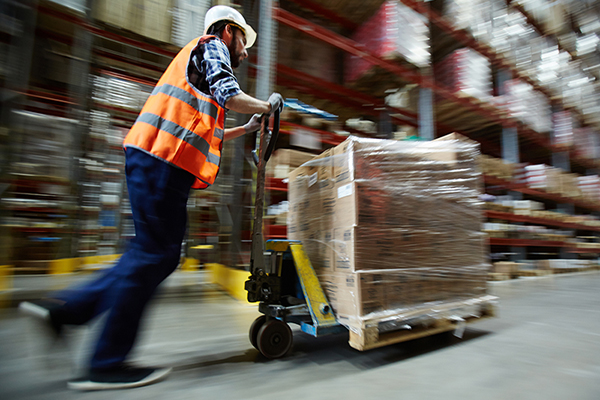Amazon Reportedly Focusing on Expanding its Delivery Trial Offering Threatening FedEx & UPS

According to Bloomberg, Amazon is expanding its FBA Onsite service, previously called Seller Flex, to make more groceries, cleaning supplies and other products available for quick delivery directly from merchants without overwhelming the e-commerce giant’s warehouses with additional inventory, according.
Last fall, Bloomberg reported that Amazon was working on a new delivery offering geared towards making more products available for free two-day delivery while helping to relieve overcrowded warehouses, with this initiative driving the global ecommerce power into services typically handled for Amazon by UPS and FedEx.
The report, which was published in October, explained that Amazon first began work on this service, entitled Seller Flex, in India in 2015 and subsequently “slowly marketing” it to United States-based merchants with an eye on a national expansion.
And it noted that its U.S. launch kicked off on the West Coast earlier last year, which is expected to be followed by what the report called a broader rollout.
In terms of how Seller Flex works, Bloomberg said that Amazon will oversee package pickups from the warehouses of third-party merchants selling goods through Amazon.com and delivery to customers’ homes.
These tasks are currently handled for Amazon by UPS and FedEx. And while Amazon may still use UPS and FedEx for delivery, the report said that Amazon will decide how to send a package, as opposed to leaving that at the discretion of the seller.
Among the benefits of handling more deliveries for Amazon, cited in the report, are things like providing greater flexibility and control over the last mile to consumer’s homes, saving money through volume discounts, and helping to avoid congestion in Amazon warehouses through keeping merchandise in outside sellers’ facilities.
Other noted benefits include how Seller Flex would provide Amazon with more flexibility into warehousing and delivery operations of merchant partners, with the potential of making full use of their product inventory, storage, space, and customer proximity with a quick delivery guarantee.
A separate Bloomberg report, which was published today, indicated that Amazon has expanded the Seller Flex service, which Amazon has renamed to FBA Onsite.
The report explained that along with changing the name of the offering, Amazon is recruiting more sellers and telling merchants they can keep goods in their own warehouses, as in the past merchants had to send goods to Amazon facilities and then pay extra fees to participate in FBA Onsite, as well as Amazon’s household goods fulfillment service called Subscribe and Save that offers discounts on frequently purchased items.
Among the benefits of FBA Onsite cited in the report were: increasing inventory; shortening delivery times; reducing costs; and letting merchants send inventory to Amazon warehouses and pay Amazon to handle storage, packing and delivery.
Related: Amazon Crushes Earnings
FBA Onsite is interesting from a delivery and distribution on a few different levels, according to Jerry Hempstead, president of Hempstead Consulting, in a recent interview.
“It's for retailers that peddle their products on the Amazon site. So in some situations, dependent on volume, of course, it’s more efficient to pick up some packages I think they are looking at regional footprints) and inject the volumes directly,” he said.
This is in lieu of moving volume from retailer to Amazon fulfillment and then from Amazon fulfillment to consumer. This next logical step can reduce mileage on a piece of inventory, reduce handling, and reduce time to consumer gratification.”
As for the potential impact of FBA Onsite on UPS and FedEx, Hempstead said it is not perceived as a “huge threat,” saying it is more of a logical nuance. And he noted that some retailers that use Amazon to sell their items select their own carrier today but are required to meet Amazon’s delivery requirements and some of that business may be subject to diversion away from the integrators.
“I think this new offering will be limited in clientele and delivery footprint,” said Hempstead.
A research note issued last fall by Baird and Co. analyst Colin Sebastian said that Amazon’s final-mile efforts reflect a logical extension to its model as it builds network density, justifying incremental insourcing of purchased transportation spend, as well as ongoing efforts to continue managing rising costs in its final-mile delivery network.
Read: Is Amazon About to Disrupt Another Billion-Dollar Market – Third Party Logistics?
In recent years, Amazon has been diligent in expanding its own logistics network in the form of things like opening 20 regional sort centers and launching its own air network contracting with ATSG and Atlas Airlines.
Other logistics-related efforts of note by Amazon include things like testing drone delivery of parcels and building an Uber-like app for freight, among others.
Related: Amazon Doesn’t Have Enough Route Density for Its Own Delivery Service
Related 'Amazon' White Papers
Amazon’s Move into Delivery Logistics
Many industry players and experts are waiting anxiously to see what innovations Amazon will come up with next – and above all, whether Amazon will enter into delivery logistics under its own banner. Download Now!
Chasing Amazon: Building a Dynamic Warehouse Network
Most of Amazon’s competitors are feverishly playing catch-up, and if your company is among them, reassessing your supply chain design, particularly pricing and quick delivery, is a good place to start. Download Now!
Amazon: Yet Another Massive Market on the Horizon
Amazon has “powerhouse potential” in the large transportation and logistics market, dominated by global enterprises such as DHL, FedEx, and UPS. Download Now!
Home Delivery and Same-Day Delivery for Retailers
Retailers are struggling to respond to the new threat of online giants like Amazon, who are siphoning off the customers of traditional retailers, what is driving this and what can retailers do to retaliate against this threat? Download Now!
How Industrial Distributors Should Compete with AmazonSupply
Companies that recognize and respond to the shift in power to the customer are winning hearts and wallets, the key is not to get hung up on trying to save a penny. Download Now!
Global E-Commerce Logistics
Regardless of who is winning the race for volumes and profits, consumers continue to spend and the e-commerce logistics market continues to grow. Download Now!
State of Online Freight Sales
While many business-to-business sales industries continue to expand sales online, the logistics industry has been slow to adopt online freight sales and booking, leaving ample space for ambitious forwarders to expand sales with new channels. Download Now!
More “Amazon” Related Papers
Article Topics
Amazon News & Resources
Amazon Logistics’ Growth Shakes Up Shipping Industry in 2023 The Harsh Reality for Amazon and Walmart Warehouse Workers Parcel experts examine the UPS-United States Postal Service air cargo relationship amid parcel landscape Will recent talks between FedEx and Amazon lead to a reunion? C.H. Robinson President & CEO Bozeman provides overview of key logistics trends and themes at SMC3 JumpStart 2024 Plug Power completes first Installation of electrolyzer at Amazon fulfillment center Major parcel carriers turn in strong Cyber Week on-time performance levels, reports ShipMatrix More AmazonLatest in Transportation
Talking Supply Chain: Doomsday never arrives for Baltimore bridge collapse impacts Amazon Logistics’ Growth Shakes Up Shipping Industry in 2023 Nissan Channels Tesla With Its Latest Manufacturing Process Why are Diesel Prices Climbing Back Over $4 a Gallon? Luxury Car Brands in Limbo After Chinese Company Violates Labor Laws The Three Biggest Challenges Facing Shippers and Carriers in 2024 Supply Chain Stability Index: “Tremendous Improvement” in 2023 More TransportationAbout the Author





















